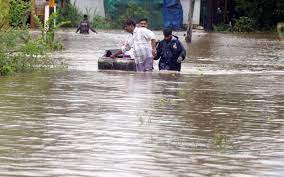Kerala Floods:

Kerala once again stares at a flood-like situation, similar to the one in 2018, with high intensity rain triggered by strong monsoon winds.
- In addition, a low-pressure system is expected to form within 2-3 days over the Bay of Bengal, which is likely to aggravate the rains.
- It is an overflowing of water onto land that is normally dry. Floods can occur during heavy rains, when ocean waves come on shore, when snow melts quickly, or when dams or levees break.
- Damaging flooding may happen with only a few inches of water, or it may cover a house to the rooftop.
- Floods can occur within minutes or over a long period, and may last days, weeks, or longer.
- Floods are the most common and widespread of all weather-related natural disasters.
- Flash floods are the most dangerous kind of floods, because they combine the destructive power of a flood with incredible speed.
- Unplanned development, encroachments in riparian zones, failure of flood control structures, unplanned reservoir operations, poor drainage infrastructure, deforestation, land use change and sedimentation in riverbeds exacerbate floods.
- When rainfall is heavy, the river breaches the embankments and destroys habitations along the banks and on the sandbars.
- Unplanned Urbanisation: Flooding in the cities and the towns has become a frequent phenomenon.
- The reason for this is indiscriminate encroachment of waterways and wetlands, inadequate capacity of drains and lack of maintenance of the drainage infrastructure.
- Poor waste management also exacerbates the problem by blocking drains, canals and lakes.
- Neglecting Pre-Disaster Planning: History of flood management shows that focus of disaster management has largely been on post-flood recovery and relief.
- Many reservoirs and Hydro-electric plants do not have enough gauging stations for measurement of flood level, which is the principal component for flood prediction and forecast.




